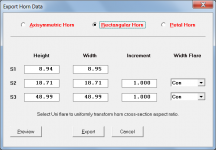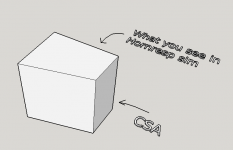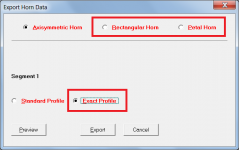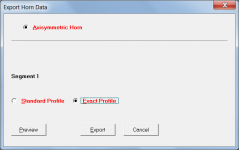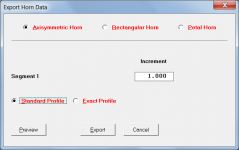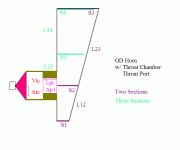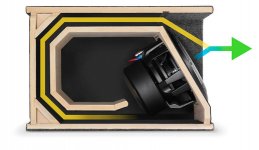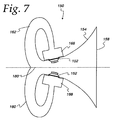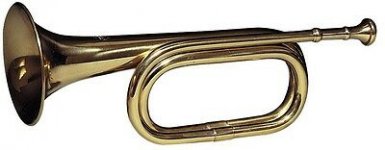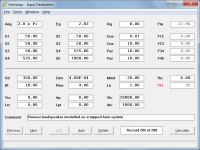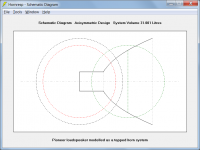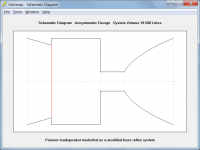Everything is round in the sims and if you want it square/whatever, use the 'export horn data' feature in HELP and not having ever even looked at it, not sure if it will convert to trapezoid, but S2 is the small end of S1, so convert these areas to the equivalent trapezoid and if you want to know it at point along L12, then AFAIK it's way beyond my math skills.
GM
GM
In the case of a cabinet of fixed width with a straigth expansion on the other axis, only one dimension is expanding.
Hi pabloko,
The above system should be simulated in Hornresp using the Par (parabolic) flare profile.
Kind regards,
David
And if all goes well, there will be a book about horn speakers published sometime at the end of this year 😉
Having seen a recent draft of the manuscript (the book is being co-authored by Bjørn) I can safely say that it will quickly become a classic - THE standard reference work on horn loudspeaker systems, and a "must have" for anyone interested in the history, theory and design of high quality sound reproduction systems using horn speakers.
Everything is round in the sims and if you want it square/whatever, use the 'export horn data' feature
Attachments
csa versus diagram in HR
As I am constantly reminded, I am "mental". Got up this morning and realized what exactly CSA means in regard to the actual 3D model that HR is simulating. Once I "grokked" CSA, I could then design my box, since I know the width already. Thanks David and GM. I'm going back to my morning coffee cup.
View attachment 744803
Folks,
So I have produced a Tapered TL that has acceptable size, F3, and TL length for my drivers.
Question: All I see in the Loudspeaker Wizard is the cross section area of each segment, but the schematic shows system volume. Where does it get the internal width from for the volume calculation?
Second Question - so my S1 has a particular cross section area, and it has the shape of a trapezoid. I know the length = L12. Is there any way to determine the dimensions for the large end and small end of S1?
Apologies if this is remedial geometry.
Thanks in advance.
As I am constantly reminded, I am "mental". Got up this morning and realized what exactly CSA means in regard to the actual 3D model that HR is simulating. Once I "grokked" CSA, I could then design my box, since I know the width already. Thanks David and GM. I'm going back to my morning coffee cup.
Attachments
Hornresp Update 4910-190324
Hi Everyone,
CHANGE
When the construction data for a Le Cléac'h horn is exported it is possible to specify either the standard 2007 flare profile (which becomes slightly inaccurate near the horn mouth) or the exact axisymmetric profile.
Previously when the Exact Profile option was selected it was possible to choose from either the Axisymmetric Horn, Rectangular Horn or Petal Horn options, even though only the axisymmetric profile data would be exported, regardless of the option chosen. Attachment 1 refers.
Now when the Exact Profile option is selected, the Rectangular Horn and Petal Horn options are hidden to avoid any confusion. Attachment 2 refers.
(The axisymmetric, rectangular and petal horn data export options are all still available when the Standard Profile option is selected. Attachment 3 refers).
Kind regards,
David
Hi Everyone,
CHANGE
When the construction data for a Le Cléac'h horn is exported it is possible to specify either the standard 2007 flare profile (which becomes slightly inaccurate near the horn mouth) or the exact axisymmetric profile.
Previously when the Exact Profile option was selected it was possible to choose from either the Axisymmetric Horn, Rectangular Horn or Petal Horn options, even though only the axisymmetric profile data would be exported, regardless of the option chosen. Attachment 1 refers.
Now when the Exact Profile option is selected, the Rectangular Horn and Petal Horn options are hidden to avoid any confusion. Attachment 2 refers.
(The axisymmetric, rectangular and petal horn data export options are all still available when the Standard Profile option is selected. Attachment 3 refers).
Kind regards,
David
Attachments
Nice. Downloading as I type. And now I have some more horn work to get accomplished.
And it couldn't be done without Hornresp. My eternal gratitude for this awesome program David.
And it couldn't be done without Hornresp. My eternal gratitude for this awesome program David.
Can you allow room gain functionality in the 1-2000hz frequency range...its currently greyed out.
what's the best way to sim this in HR ?
Hi Zero D,
Your guess is as good as mine 🙂.
Given the choice between a tapped horn and a bass reflex system, I think I would be inclined to go with bass reflex, but that is just a "gut feeling" on my part. What happens when you simulate using these two models? Are the results similar in any way, or are they completely different?
Kind regards,
David
Can you allow room gain functionality in the 1-2000hz frequency range.
Hi Etocynned,
Hornresp imported room gain values are limited to the frequency range 10 to 20000 hertz. This is not going to change.
I suspect that it could be quite difficult to obtain accurate sub-10Hz room gain figures anyway 🙂.
Kind regards,
David
My eternal gratitude for this awesome program David.
Hi Mark,
Glad to be of service 🙂.
Kind regards,
David
Hi Zero D,
Your guess is as good as mine 🙂.
Given the choice between a tapped horn and a bass reflex system, I think I would be inclined to go with bass reflex, but that is just a "gut feeling" on my part. What happens when you simulate using these two models? Are the results similar in any way, or are they completely different?
Kind regards,
David
These enclosures are tapped horns with throat chambers.
Pic 3 is a guideline to use for HR even though it's an offset driver front loaded horn.
Attachments
Originally Posted by David McBean
Your guess is as good as mine 🙂.
Gotcha 😉
@ BP1Fanatic
Thanx for posting 🙂
I had forgotten about the Pruden PAT & the other one 🙁
The Pruden & the one underneath it, both have the drivers facing into the devices.
Several years on here ago i asked if due account should be made for polarity when doing that with TH's. I was told no ! I'm still not sure ?
The one in the middle of the group of three is not a tapped horn. It is a vented box with a long port. Lot's of those masquerading as tapped horns. If there is no throat to mouth taper and a tapped point in the path it isn't a tapped horn.
I will refrain from mentioning gain over and equally sized box.
Oooops!
I will refrain from mentioning gain over and equally sized box.
Oooops!
other than high frequency extension, which way the cone faces matters little as far as output of the horn(band width of interest) but when it comes to polarity would that not be dictated by how it sums to adjacent bands?
The one in the middle of the group of three is not a tapped horn. It is a vented box with a long port. Lot's of those masquerading as tapped horns. If there is no throat to mouth taper and a tapped point in the path it isn't a tapped horn.
I will refrain from mentioning gain over and equally sized box.
Oooops!
True, a standard TH has a constant positive flare.
However, you can use the TH function in HR to model positive, straight, and negative flare enclosures.
The Pioneer and JL Audio enclosures look live bugle horns!
Attachments
True, a standard TH has a constant positive flare.
However, you can use the TH function in HR to model positive, straight, and negative flare enclosures.
The Pioneer and JL Audio enclosures look live bugle horns!
Yes sir eee!
But the short little exaggerated vent types have a place in live sound. You get a nice big peak in output right around kick drum 110 to 130 hertz. No replacement for efficiency.
What happens when you simulate using these two models? Are the results similar in any way, or are they completely different?
My curiosity got the better of me - I simulated the Pioneer design (not to scale) both as a tapped horn and as a bass reflex system with the port tube flared at the exit and the direct radiator output side appropriately loaded. Attachments 1 and 2 show the tapped horn system, Attachments 3 and 4 show the "modified" bass reflex system. Attachment 5 compares the responses of the two models (grey trace is tapped horn system, black trace is bass reflex system).
Considering that the results are calculated using completely different methods in the two models, it is pleasing indeed to see that the responses are very similar up to about 1000 hertz - yet another example of the flexibility of the Hornresp simulation models 🙂.
VERDICT - It seems that you can use either model, but my original "gut feeling" bass reflex choice gives a slightly nicer-looking response at the higher frequencies 🙂
Attachments
- Home
- Loudspeakers
- Subwoofers
- Hornresp
